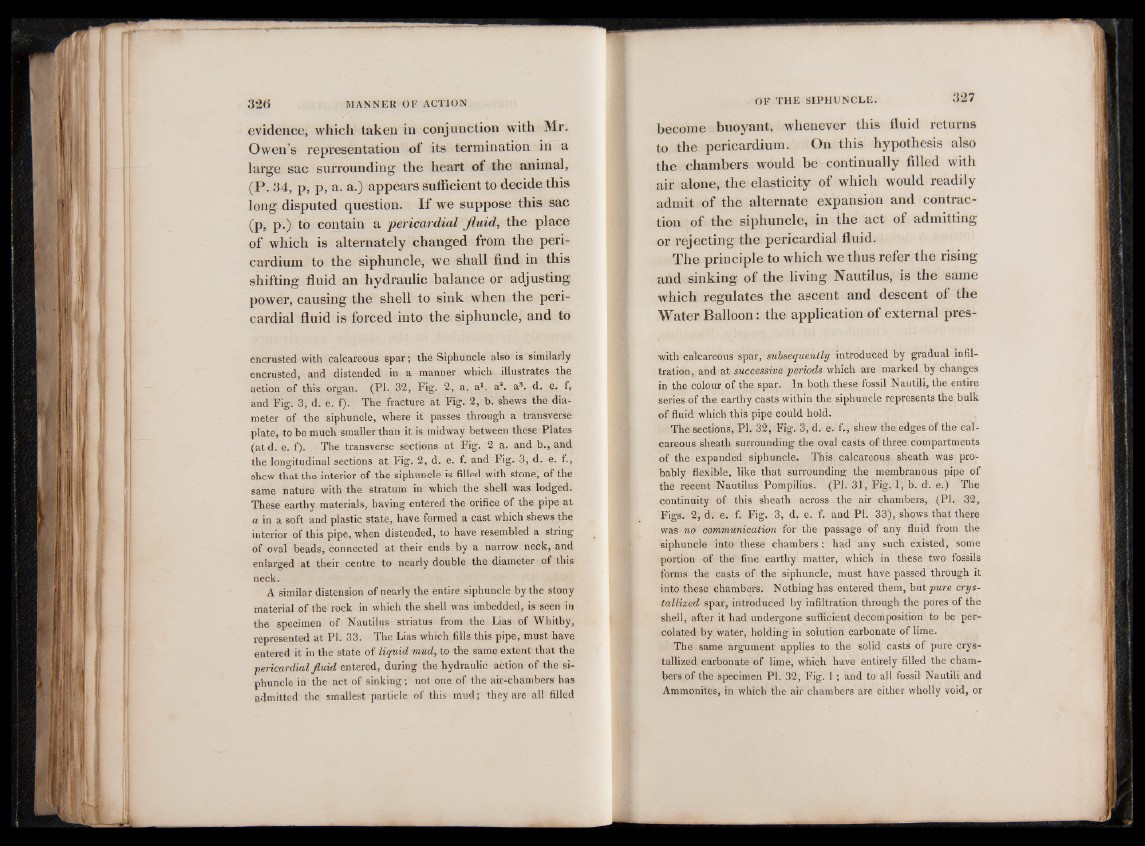
evidence, which taken in conjunction with Mr.
Owen’s representation of its termination in a
large sac surrounding the heart of the animal,
(P. 3 4 , p, p, a. a.) appears sufficient to decide this
long disputed question. I f we suppose this sac
(p, p.) to contain a pericardial fluid, the place
of which is alternately changed from the pericardium
to the siphuncle, we shall find in this
shifting fluid an hydraulic balance or adjusting
power, causing the shell to sink when the pericardial
fluid is forced into the siphuncle, and to
encrusted with calcareous spar; the Siphuncle also is similarly
encrusted, and distended in a manner which illustrates the
action of this organ. (PI. 32, Fig. 2, a. a1, a3, a3, d. e. f,
and Fig. 3, d. e. f). The fracture at Fig. 2, b. shews the diameter
of the siphuncle, where it passes through a transverse
plate, to be much smaller than it is midway between these Plates
(at d. e. f). The transverse sections at Fig. 2 a. and b., and
the longitudinal sections at Fig. 2, d. e. f. and Fig. 3, d. e. f.,
shew that the interior of the siphuncle is filled with stone, of the
same nature with the stratum in which the shell was lodged.
These earthy materials, having entered the orifice of the pipe at
a in a soft and plastic state, have formed a cast which shews the
interior of this pipe, when distended, to have resembled a string
of oval beads, connected at their ends by a narrow neck, and
enlarged at their centre to nearly double the diameter of this
neck.
A similar distension of nearly the entire siphuncle by the stony
material of the rock in which the shell was imbedded, is seen in
the specimen of Nautilus striatus from the Lias of Whitby,
represented at PI. 33. The Lias which fills this pipe, must have
entered it in the state of liquid mud, to the same extent that the
■pericardial fluid entered, during the hydraulic action of the siphuncle
in the act of sinking; not one of the air-chambers has
admitted the smallest particle of this mud; they are all filled
become buoyant, whenever this fluid returns
to the pericardium. On this hypothesis also
the chambers would be continually filled with
air alone, the elasticity of which would readily
admit of the alternate expansion and contraction
of the siphuncle, in the act of admitting
or rejecting the pericardial fluid.
The principle to which we thus refer the rising
and sinking of the living Nautilus, is the same
which regulates the ascent and descent of the
Water Balloon: the application of external preswith
calcareous spar, subsequently introduced by gradual infiltration,
and at successive periods which are marked by changes
in the colour of the spar. In both these fossil Nautili, the entire
series of the earthy casts within the siphuncle represents the bulk
of fluid which this pipe could hold.
The sections, PI. 32, Fig. 3, d. e. f., shew the edges of the calcareous
sheath surrounding the oval casts of three compartments
of the expanded siphuncle. This calcareous sheath was probably
flexible, like that surrounding the membranous pipe of
the recent Nautilus Pompilius. (PI. 31, Fig. 1, b. d. e.) The
continuity of this sheath across the air chambers, (Pi. 32,
Figs. 2, d. e. f. Fig. 3, d. e. f. and PI. 33), shows that there
was no communication for the passage of any fluid from the
siphuncle into these chambers: had any such existed, some
portion of the fine earthy matter, which in these two fossils
forms the casts of the siphuncle, must have passed through it
into these chambers. Nothing has entered them, butpwre crystallized
spar, introduced by infiltration through the pores of the
shell, after it had undergone sufficient decomposition to be percolated
by water, holding in solution carbonate of lime.
The same argument applies to the solid casts of pure crystallized
carbonate of lime, which have entirely filled the chambers
of the specimen PI. 32, Fig. 1 ; and to all fossil Nautili and
Ammonites, in which the air chambers are either wholly void, or